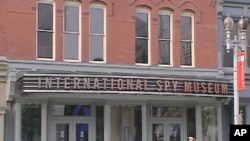The International Spy Museum in Washington is hoping to add to its collection of espionage materials following the recent spy swap between the United States and Russia. The exchange was the largest between the two nations since the end of the Cold War. The case against as many as 12 Russians reads like a spy caper, with 10 of them already exchanged for four prisoners in Russia.
The museum is no more than 10 kilometers from where three of the Russian agents lived just outside Washington. And near the entrance to the exhibit are photos of uncovered Soviet spies. In a separate room is what is called the Spy School.
There is a car from a James Bond movie. On a normal day it would be a hit of the exhibit, as would the pistol made to look like a lipstick and a lethal umbrella. In light of the spy scandal, perhaps the most popular display is an unremarkable piece of paper. It contains a hidden message. Historian Mark Stawt says this method of passing on data was used by the recently deported Russian agents.
"In this particular case, we have a purchase order. Then, underneath it, we have a secret message hidden, which comes out under ultraviolet light. There are many different ways of doing this but this is a very traditional technique that has been around for a century and the Russians used it in this recent case," he said.
Taking a few steps to the side, our camera crew finds itself under observation. As it turns out, it's not only our cameraman who records everything that is happening around us. There is the camera hidden in a pair of glasses. Next to a dummy is a suitcase. Anyone who tries to appropriate it will be dealt a high-voltage shock.
Stawt demonstrates elaborate devices developed by the CIA and KGB. "One example that I particularly like is the shoe - a concealed device - like you see here used by KGB in the 1980s. Concealed devices basically could be any every day object, in which you hide incriminating materials. So typically film, but it could be communications equipment," he said.
A vodka bottle, as well as a jar of face cream, were used to transport microfilm. And a crest was given to the American ambassador by Soviet pioneers. Only six years later Embassy employees discovered that it had an electronic bug built in. Seen against a background of modern computer technologies, the museum exhibits look more like props for filming spy movies. But some of them are still used by real spies.
Recent Russian Spy Case Good Fit for Spy Museum in Washington










